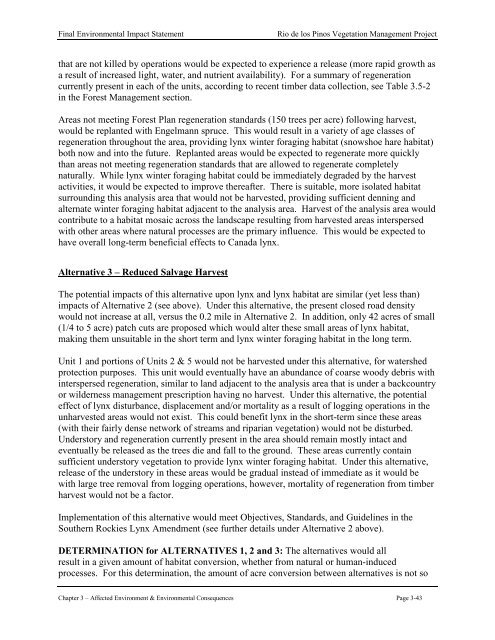Final Environmental Impact Statement Rio de los Pinos Vegetation ...
Final Environmental Impact Statement Rio de los Pinos Vegetation ...
Final Environmental Impact Statement Rio de los Pinos Vegetation ...
You also want an ePaper? Increase the reach of your titles
YUMPU automatically turns print PDFs into web optimized ePapers that Google loves.
<strong>Final</strong> <strong>Environmental</strong> <strong>Impact</strong> <strong>Statement</strong> <strong>Rio</strong> <strong>de</strong> <strong>los</strong> <strong>Pinos</strong> <strong>Vegetation</strong> Management Project<br />
that are not killed by operations would be expected to experience a release (more rapid growth as<br />
a result of increased light, water, and nutrient availability). For a summary of regeneration<br />
currently present in each of the units, according to recent timber data collection, see Table 3.5-2<br />
in the Forest Management section.<br />
Areas not meeting Forest Plan regeneration standards (150 trees per acre) following harvest,<br />
would be replanted with Engelmann spruce. This would result in a variety of age classes of<br />
regeneration throughout the area, providing lynx winter foraging habitat (snowshoe hare habitat)<br />
both now and into the future. Replanted areas would be expected to regenerate more quickly<br />
than areas not meeting regeneration standards that are allowed to regenerate completely<br />
naturally. While lynx winter foraging habitat could be immediately <strong>de</strong>gra<strong>de</strong>d by the harvest<br />
activities, it would be expected to improve thereafter. There is suitable, more isolated habitat<br />
surrounding this analysis area that would not be harvested, providing sufficient <strong>de</strong>nning and<br />
alternate winter foraging habitat adjacent to the analysis area. Harvest of the analysis area would<br />
contribute to a habitat mosaic across the landscape resulting from harvested areas interspersed<br />
with other areas where natural processes are the primary influence. This would be expected to<br />
have overall long-term beneficial effects to Canada lynx.<br />
Alternative 3 – Reduced Salvage Harvest<br />
The potential impacts of this alternative upon lynx and lynx habitat are similar (yet less than)<br />
impacts of Alternative 2 (see above). Un<strong>de</strong>r this alternative, the present c<strong>los</strong>ed road <strong>de</strong>nsity<br />
would not increase at all, versus the 0.2 mile in Alternative 2. In addition, only 42 acres of small<br />
(1/4 to 5 acre) patch cuts are proposed which would alter these small areas of lynx habitat,<br />
making them unsuitable in the short term and lynx winter foraging habitat in the long term.<br />
Unit 1 and portions of Units 2 & 5 would not be harvested un<strong>de</strong>r this alternative, for watershed<br />
protection purposes. This unit would eventually have an abundance of coarse woody <strong>de</strong>bris with<br />
interspersed regeneration, similar to land adjacent to the analysis area that is un<strong>de</strong>r a backcountry<br />
or wil<strong>de</strong>rness management prescription having no harvest. Un<strong>de</strong>r this alternative, the potential<br />
effect of lynx disturbance, displacement and/or mortality as a result of logging operations in the<br />
unharvested areas would not exist. This could benefit lynx in the short-term since these areas<br />
(with their fairly <strong>de</strong>nse network of streams and riparian vegetation) would not be disturbed.<br />
Un<strong>de</strong>rstory and regeneration currently present in the area should remain mostly intact and<br />
eventually be released as the trees die and fall to the ground. These areas currently contain<br />
sufficient un<strong>de</strong>rstory vegetation to provi<strong>de</strong> lynx winter foraging habitat. Un<strong>de</strong>r this alternative,<br />
release of the un<strong>de</strong>rstory in these areas would be gradual instead of immediate as it would be<br />
with large tree removal from logging operations, however, mortality of regeneration from timber<br />
harvest would not be a factor.<br />
Implementation of this alternative would meet Objectives, Standards, and Gui<strong>de</strong>lines in the<br />
Southern Rockies Lynx Amendment (see further <strong>de</strong>tails un<strong>de</strong>r Alternative 2 above).<br />
DETERMINATION for ALTERNATIVES 1, 2 and 3: The alternatives would all<br />
result in a given amount of habitat conversion, whether from natural or human-induced<br />
processes. For this <strong>de</strong>termination, the amount of acre conversion between alternatives is not so<br />
Chapter 3 – Affected Environment & <strong>Environmental</strong> Consequences Page 3-43
















